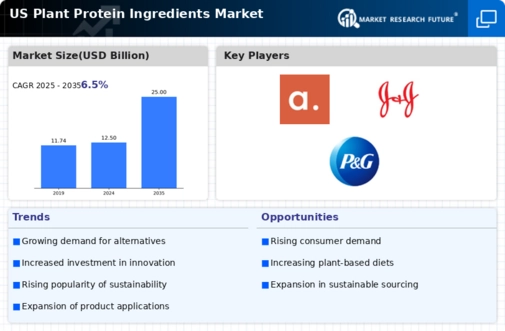Innovation in Food Technology
Technological advancements in food processing and formulation are playing a pivotal role in the growth of the plant protein-ingredients market. Innovations such as improved extraction methods and enhanced flavor profiles are making plant-based proteins more appealing to a broader audience. For instance, the development of texturized vegetable proteins has allowed manufacturers to create meat-like textures that cater to the growing demand for plant-based meat alternatives. Market data suggests that the plant protein-ingredients market is projected to reach $10 billion by 2027, driven in part by these technological innovations. As food technology continues to evolve, it is likely that new applications for plant proteins will emerge, further expanding the market and attracting diverse consumer segments.
Health Conscious Consumer Behavior
The increasing awareness of health and wellness among consumers appears to be a primary driver for the plant protein-ingredients market. As individuals become more health-conscious, they tend to seek alternatives to animal-based proteins, which are often perceived as less healthy. This shift in consumer behavior is reflected in market data, indicating that the demand for plant-based protein products has surged by approximately 25% over the past few years. The plant protein-ingredients market is benefiting from this trend, as consumers actively seek products that align with their health goals, such as lower cholesterol and higher fiber content. Furthermore, the rise of lifestyle-related diseases has prompted consumers to adopt diets rich in plant proteins, further propelling the growth of the market. This trend suggests a sustained interest in plant-based options, which could continue to shape the industry in the coming years.
Sustainability and Environmental Concerns
Sustainability has emerged as a crucial factor influencing the plant protein-ingredients market. With growing concerns about climate change and environmental degradation, consumers are increasingly inclined to choose plant-based proteins over traditional animal sources. The environmental impact of livestock farming, including greenhouse gas emissions and land use, has led to a shift in consumer preferences. Reports indicate that plant-based diets can reduce an individual's carbon footprint by up to 50%. This awareness is driving innovation within the plant protein-ingredients market, as companies strive to develop sustainable sourcing practices and eco-friendly products. As consumers prioritize sustainability, the market is likely to see a continued influx of plant-based protein options that align with these values, potentially reshaping the landscape of food production and consumption.
Regulatory Support for Plant-Based Products
Regulatory frameworks in the US are increasingly supportive of plant-based products, which is likely to bolster the plant protein-ingredients market. Government initiatives aimed at promoting sustainable agriculture and healthier eating habits are encouraging the development and consumption of plant-based proteins. For example, the USDA has introduced guidelines that emphasize the importance of plant-based foods in a balanced diet. This regulatory support not only enhances consumer confidence but also incentivizes manufacturers to invest in plant protein-ingredients. As policies continue to evolve, the market may experience accelerated growth, with more companies entering the space to meet the rising demand for compliant and health-oriented products.
Rising Popularity of Vegan and Vegetarian Diets
The increasing adoption of vegan and vegetarian diets is a notable driver for the plant protein-ingredients market. As more individuals choose to eliminate or reduce animal products from their diets, the demand for plant-based protein sources has intensified. Recent surveys indicate that approximately 10% of the US population identifies as vegan, with an additional 30% considering themselves flexitarians. This shift in dietary preferences is prompting food manufacturers to expand their offerings of plant protein-ingredients, catering to a diverse range of consumers. The plant protein-ingredients market is likely to benefit from this trend, as it aligns with the growing desire for ethical and sustainable food choices. As the popularity of these diets continues to rise, the market may see further innovations and product developments aimed at satisfying consumer needs.














Leave a Comment